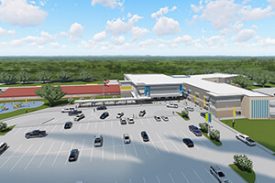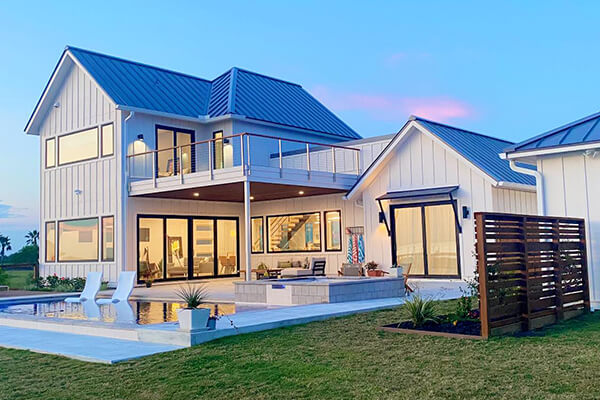- About Us
Resources
"After years of working together, we use Lynn Engineering exclusively and tell the families that we’re building for that they are in good hands."
— Krystle Henson,
KC Coastal, LLC
- ServicesOur team has spent years working throughout the Texas Coastal Bend on projects for both public and private sectors, developing lasting relationships with our clients.
Specializing in designing projects located in the high wind zones of the Texas Gulf Coast. Our experience includes mild reinforced concrete, post-tensioned concrete, timber, steel, and masonry structures.
Windstorm regulations are complex. We will engineer your new construction or alteration project to meet the design requirements of the code.
Land planning, zoning assistance, stormwater analysis and cost estimation for both commercial and residential clients.
Our team has spent years working throughout the Texas Coastal Bend on projects for both public and private sectors, developing lasting relationships with our clients.Specializing in designing projects located in the high wind zones of the Texas Gulf Coast. Our experience includes mild reinforced concrete, post-tensioned concrete, timber, steel, and masonry structures.
Windstorm regulations are complex. We will engineer your new construction or alteration project to meet the design requirements of the code.
Land planning, zoning assistance, stormwater analysis and cost estimation for both commercial and residential clients.
We employ a full-time architecture staff. Our clients benefit from a one-stop shop from planning to design and on to construction.
- Locations
Matagorda, Brazoria, Calhoun, Jackson, Galveston, Chambers and Jefferson Counties
Aransas, Refugio and San Patricio Counties
San Patricio, Nueces, Kleberg and Kenedy Counties
Development in and around the Dallas-Ft. Worth MSA
Matagorda, Brazoria, Galveston, Chambers and Jefferson Counties
Aransas, Refugio and San Patricio Counties
San Patricio, Nueces, Kleberg and Kennedy Counties
Development in and around the Dallas-Ft. Worth MSA
- Projects
Rohe Builders partnered with Lynn Engineering to build a beautiful custom home on the coast in Seadrift, Texas with a wall of large windows that produce beautiful panoramic…
TideWater Properties, a custom homebuilder in Rockport, Texas worked with Lynn Engineering to design and build a beautiful waterfront home on the Texas Gulf Coast.The historic BayTex Hotel on West Sixth Street in Bay City, Texas, first opened in 1927 with 49 guest rooms and a first-floor restaurant, becoming the crown jewel…
The community of Port O’Connor, Texas, south of Victoria on West Matagorda Bay, has experienced growth in recent years. The vacuum or pneumatic sewer system installed in 2000 has been underperforming of late.
Rohe Builders partnered with Lynn Engineering to build a beautiful custom home on the coast in Seadrift, Texas with a wall of large windows that produce beautiful panoramic…
TideWater Properties, a custom homebuilder in Rockport, Texas worked with Lynn Engineering to design and build a beautiful waterfront home on the Texas Gulf Coast.The historic BayTex Hotel on West Sixth Street in Bay City, Texas, first opened in 1927 with 49 guest rooms and a first-floor restaurant, becoming the crown jewel…
The community of Port O’Connor, Texas, south of Victoria on West Matagorda Bay, has experienced growth in recent years. The vacuum or pneumatic sewer system installed in 2000 has been underperforming of late.
- Careers
"The people I work with are interested in me as a person, and not just the job that I do."
— Brandi, Client Relations Specialist
Since August 2016Open Positions
Our Culture
"The people I work with are interested in me as a person, and not just the job that I do."
— Brandi, Client Relations Specialist
Since August 2016
Let's talk about cathedral ceilings
Understanding the Structural Engineering Challenges and Benefits of Vaulted and Cathedral Ceilings in Home Construction
Vaulted and cathedral ceilings have become increasingly popular in modern home design. They are a great way to create an open and airy feel in living spaces. This feature not only adds aesthetic appeal to homes but can add value as well. However, these types of ceilings also present unique structural engineering challenges that must be addressed before and during the construction process.
One of the primary challenges of vaulted and cathedral ceilings is the increased weight they place on the supporting structure. The higher the ceiling, the greater the weight of the roofing materials and the greater the risk of structural failure. This is particularly true in areas with high winds, where uplift forces can add even more stress to the structure.

Increased weight is not always the primary challenge. The vault removes the ceiling joists that help fight the rafters kicking out the walls. To combat this the ridge becomes a support beam with posts/stud packs on either side to eliminate the kick out.
To address these challenges, it is important to ensure that the supporting structure is designed and built to withstand the additional weight and stress of the vaulted or cathedral ceiling. This may involve using larger or stronger beams, trusses or rafters, or incorporating additional support columns or walls to distribute the weight more evenly.

Another important consideration is the potential for deflection or movement in the supporting structure over time. Vaulted and cathedral ceilings can create greater horizontal and vertical stresses on the structure, which can lead to sagging, cracking or other forms of damage if not properly addressed. This can be mitigated through careful planning and design, as well as the use of quality materials and construction techniques.
Despite these challenges, vaulted and cathedral ceilings offer several benefits that can make them a worthwhile addition to home construction. For one, they can create a feeling of spaciousness and openness in living spaces that is difficult to achieve with traditional flat ceilings. They can also allow for greater natural light to enter the home, which can improve the overall aesthetic appeal and energy efficiency of the space.

In addition, vaulted and cathedral ceilings can provide better ventilation and air flow in the home. Hot air naturally rises, so by creating more vertical space in the living areas, you can create a natural flow of air that can help regulate temperature and reduce the need for artificial heating and cooling.
When it comes to choosing the right type of ceiling for your home, there are several factors to consider, including the structural engineering challenges, the aesthetic appeal, and the potential benefits of the design. By working with an experienced structural engineer at Lynn Engineering, you can ensure that your vaulted or cathedral ceiling is properly designed and constructed to meet your specific needs and preferences.
At Lynn Engineering, we specialize in designing projects located throughout the high-wind zones of the Texas Gulf Coast. Our team of experienced engineers can help you navigate the unique structural engineering challenges presented by vaulted or cathedral ceilings and can work with you to create a design that is both beautiful and functional. Contact us today to learn more about our services and to schedule a consultation.
Let's get in touch!
- Sam Bird, P.E.
- April 15, 2023









